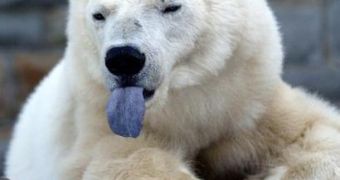This bear seems to have the shortest life of all the bear species: it appeared about 40,000 years ago, its ancestor being the brown bear (the species that includes the grizzly) and it could be gone till 2050 due to the Polar ice melting. By that year, at least 70 % of the polar bear populations will be gone and in Alaska and Russia this species will be no more.
"Only in the northern Canadian Arctic islands and the west coast of Greenland are any of the world's 16,000 polar bears expected to survive through the end of the century," states a new report from the U.S. Geological Survey.
The species will lose 42 % of the Arctic summer habitat in the Polar Basin. As a polar bear lives about 30 years, those born today will be amongst the last ones in many areas.
Polar bears need an ice platform for hunting seals, which is their main food, as seals rarely go on land and in open water they easily outrun the bears. As the general decline of Arctic sea ice seems to be underestimated, this forecast could be on the low side. "There is a definite link between changes in the sea ice and the welfare of polar bears. As the sea ice goes, so goes the polar bear. 84 % of the scientific variables affecting the polar bear's fate was tied to changes in sea ice." said Steven Amstrup, the lead author of the report.
By September 2007, the size of Arctic sea ice has reached a record low of 4.75 million sq mi (12.16 million sq km), 250,000 sq mi (640,000 sq km) less than the previous record low of 5.05 million sq mi (12.93 sq km) in September 2005.
And the effect of industrial greenhouse gases won't stop very soon.
"In spite of any mitigation of greenhouse gases, we are going to see the same amount of energy in the system for at least 20, 30, 40 years," said Mark Myers, the USGS director.
Most polar bears are now in Greenland and Svalbard (Norway), while 25 % of them live in Alaska and move to Canada and Russia. The report is made by American and Canadian researchers, following a work of six months assessing the health of three polar bear groups and their dependency on Arctic sea ice, employing "new and traditional models," said Myers. 9 separate reports on polar bears were made public in Friday.
They could help guide Interior Secretary Dirk Kempthorne's decisions to be made in January, adding the polar bear to the US endangered species' list.
World Conservation Union, based in Gland, Switzerland, says the polar bear population in the Arctic now could be of 20-25,000, but it is menaced by melting sea ice, pollution, hunting, development and tourism.
In December 2006, Kempthorne proposed designating polar bears as a "threatened" species but not "endangered", following a lawsuit in 2005 by the Center for Biological Diversity, Natural Resources Defense Council and Greenpeace.
"Our hope lies in a rapid response, including both deep and immediate carbon dioxide reductions and a full-court press on other greenhouse pollutants such as methane." said Kassie Siegel of the Arizona-based Center for Biological Diversity.
"The fate of polar bears has struck a public nerve. Fish and Wildlife officials have received 600,000 public comments so far on the proposed listing," said spokesman Chris Tollefson.
"Instead of meeting the challenge, the Bush administration is happy to float along, waiting to see if the planet, and polar bears, will sink or swim." said Edward Markey, D-Mass., chairman of the House Select Committee on Energy Independence and Global Warming, who urged Bush administration to offer polar bears federal protection.

 14 DAY TRIAL //
14 DAY TRIAL //